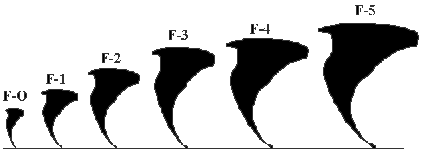|
|
|
| Under Secretary Michael Brown | Agency Background | PSAs | News Releases | Photo Library | Radio Network | Events |
| Region I | Region II | Region III | Region IV | Region V | Region VI | Region VII | Region VIII | Region IX | Region X |
| Home » Hazards » | ||||||||||||||||||||||||||||||||||||||||||||||
|
 Tornado Safety Tips Brochure Read more about Tornadoes at NOAA's Storm Prediction Center. Tornado Safety Tips Brochures Fact Sheet: TORNADOES When a tornado is coming, you have only a short amount of time to make life-or-death decisions. Advance planning and quick response are the keys to surviving a tornado. Conduct tornado drills each tornado season. Discuss with family members the difference between a "tornado watch" and a "tornado warning." Contact your local emergency management office or American Red Cross chapter for more information on tornadoes. Have disaster supplies on hand:
Develop an emergency communication plan In case family members are separated from one another during a tornado (a real possibility during the day when adults are at work and children are at school), have a plan for getting back together. Ask an out-of-state relative or friend to serve as the "family contact." After a disaster, it's often easier to call long distance. Make sure everyone in the family knows the name, address, and phone number of the contact person. Tornado Watches and Warnings A tornado watch is issued by the National Weather Service when tornadoes are possible in your area. Remain alert for approaching storms. This is time to remind family members where the safest places within your home are located, and listen to the radio or television for further developments. A tornado warning is issued when a tornado has been sighted or indicated by weather radar. Mobile Homes Mobile homes are particularly vulnerable. A mobile home can overturn very easily even if precautions have been taken to tie down the unit. When a tornado warning is issued, take shelter in a building with a strong foundation.If shelter is not available, lie in ditch or low-lying area a safe distance away from the unit. Tornado Danger Signs Learn these tornado danger signs:
DURING If at home:
If at work or school:
If outdoors:
If in a car:
AFTER
Remember to help your neighbors who may require special assistance--infants, the elderly, and people with disabilities. INSPECTING UTILITIES IN A DAMAGED HOME Check for gas leaks--If you smell gas or hear a blowing or hissing noise, open a window and quickly leave the building. Turn off the gas at the outside main valve if you can and call the gas company from a neighbor's home. If you turn off the gas for any reason, it must be turned back on by a professional. Look for electrical system damage--If you see sparks or broken or frayed wires, or if you smell hot insulation, turn off the electricity at the main fuse box or circuit breaker. If you have to step in water to get to the fuse box or circuit breaker, call an electrician first for advice. Check for sewage and water lines damage--If you suspect sewage lines are damaged, avoid using toilets and call a plumber. If water pipes are damaged, contact the water company and avoid using water from the tap. You can obtain safe water by melting ice cubes. Mitigation includes any activities that prevent an emergency, reduce the chance of an emergency happening, or lessen the damaging effects of unavoidable emergencies. Investing in preventive mitigation steps now, such as checking local building codes and ordinances about wind-resistant designs and strengthening unreinforced masonry, will help reduce the impact of tornadoes in the future. For more information on mitigation, contact your local emergency management office. Fujita - Pearson Tornado Scale 
F-0: 40-72 mph, chimney damage, tree branches broken
|
|||||||||||||||||||||||||||||||||||||||||||||
| |
Last Updated: Friday, 22-Oct-2004 21:19:00 EDT |
| Español | Privacy Policy | Accessibility | Site Help | Site Index | Contact Us | FEMA Home |
| FEMA 500 C Street, SW Washington, D.C. 20472 Phone: (202) 566-1600 |